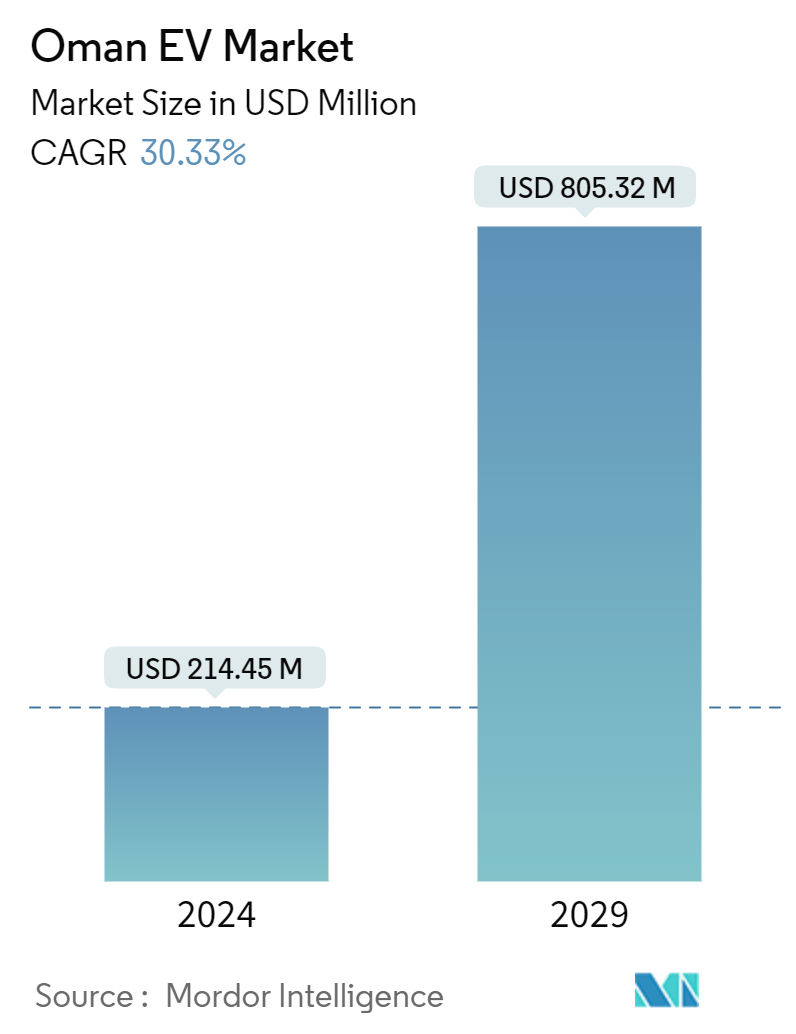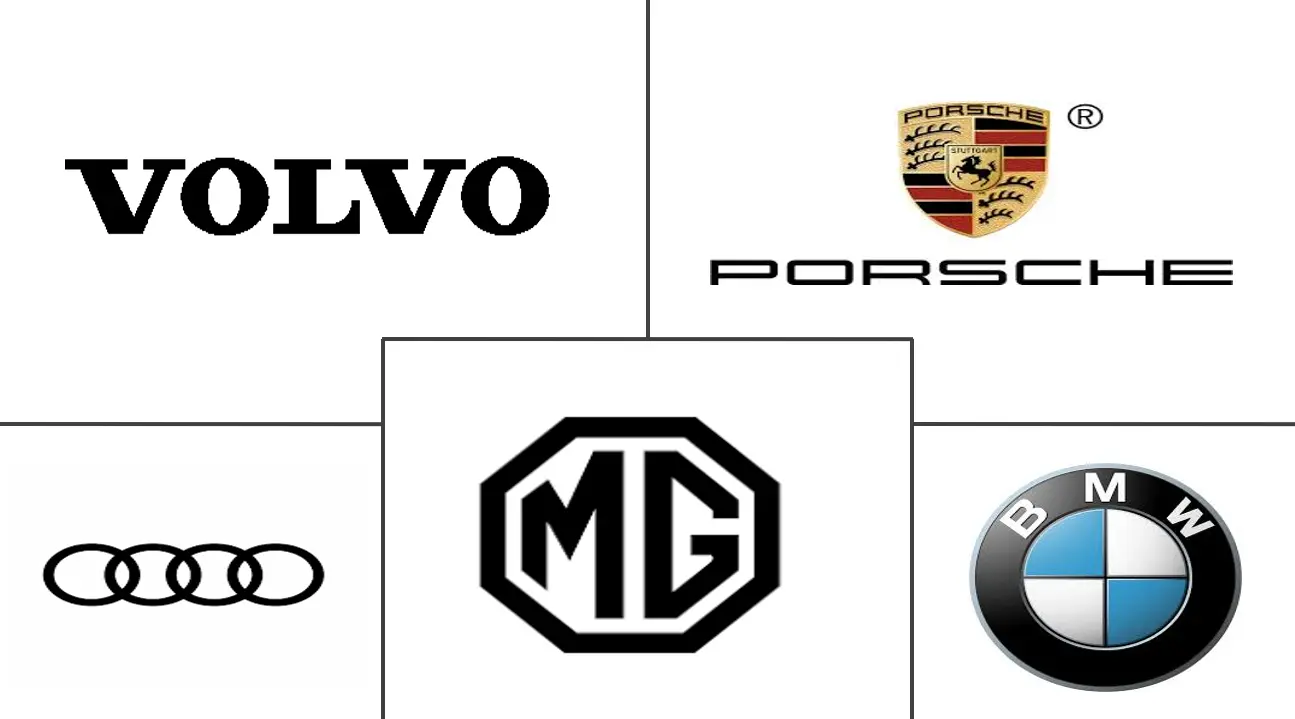Market Size of Oman EV Industry

| Study Period | 2019 - 2029 |
| Base Year For Estimation | 2023 |
| Market Size (2024) | USD 214.45 Million |
| Market Size (2029) | USD 805.32 Million |
| CAGR (2024 - 2029) | 30.33 % |
| Market Concentration | Medium |
Major Players
*Disclaimer: Major Players sorted in no particular order |
Oman EV Market Analysis
The Oman EV Market size is estimated at USD 214.45 million in 2024, and is expected to reach USD 805.32 million by 2029, growing at a CAGR of 30.33% during the forecast period (2024-2029).
Oman’s economy has traditionally been heavily reliant on oil and gas exports. However, in recent years, declining oil prices and the need to diversify the economy have prompted the government to explore alternative energy sources, including electric vehicles.
Electric vehicles are cleaner compared to traditional gasoline and diesel vehicles, as they produce zero tailpipe emissions during operation. The Omani government is actively promoting EVs by offering incentives, including tax breaks, subsidies, and exemptions on EV purchases, and has adopted initiatives to develop EV charging infrastructure as well.
- In January 2024, the Minister of Transport, Communications, and Information Technology disclosed a seven-year roadmap describing Oman’s comprehensive strategy for decarbonizing its transport sector. The plan aims to introduce an estimated 22,000 electric vehicles by 2030 and phase out all fossil fuel-powered vehicles by 2050.
Additionally, the country is also focusing on upgrading its public electric charging infrastructure, with emphasis placed on enhancing accessibility through user-friendly applications and fast, efficient chargers.
- In November 2023, Oman’s Ministry of Commerce, Industry, and Investment Promotion issued Ministerial Resolution No. 615/2023, making it mandatory for all service stations to offer electric vehicle (EV) charging capabilities.
However, the market for EVs faces several challenges and constraints, including a lack of charging infrastructure, high initial cost, and range anxiety. Despite these challenges, the Oman EV market is set for definite growth in the coming years owing to continued government support, increasing partnerships, and collaborations between the government, private stakeholders, and the private sector.
Oman EV Industry Segmentation
An electric vehicle (EV) is a vehicle powered primarily by electricity. The electricity required is stored in rechargeable batteries. In some models, it is supplied by an external source, such as a plug-in charger. EVs are considered ideal as they produce zero tailpipe emissions and offer a sustainable alternative to traditional ICE vehicles.
The Omani EV market is segmented by vehicle type, propulsion type, battery type, range, drive type, battery capacity, and end user. By vehicle type, the market is segmented into two-wheel, passenger car, and commercial vehicle. By propulsion type, the market is segmented into battery electric vehicles (BEV), hybrid electric vehicles (HEV), and plug-in hybrid electric vehicles (PHEV). By battery type, the market is segmented into LFP, NMC, and other battery types. By range, the market is segmented as upto 150 km, 151-300 km, and above 300 km. By drive type, the market is segmented as all-wheel drive, front-wheel drive, and rear-wheel drive. By battery capacity, the market is segmented as less than 20 kwh, 20-40 kwh, 40-60 kwh, 60-100 kwh, and above 100 kwh. By end user, the market is segmented as shared mobility providers, government organizations, and personal users. The report offers market size and forecast in value (USD) for all the above segments.
| Vehicle Type | |
| Two-wheeler | |
| Passenger Car | |
| Commercial Vehicle |
| Propulsion Type | |
| Battery Electric Vehicle (BEV) | |
| Hybrid Electric Vehicle (HEV) | |
| Plug-In Hybrid Electric Vehicle (PHEV) |
| Battery Type | |
| Lithium Iron Phosphate Battery (LFP) | |
| Nickel Manganese Cobalt (NMC) | |
| Other Battery Types |
| Range | |
| Upto 150 km | |
| 151-300 km | |
| Above 300 km |
| Drive Type | |
| All-wheel Drive | |
| Front-wheel Drive | |
| Rear-wheel Drive |
| Battery Capacity | |
| Less than 20 kWh | |
| 20-40 kWh | |
| 40-60 kWh | |
| 60-100 kWh | |
| Above 100 kWh |
| End-User | |
| Shared Mobility Providers | |
| Government Organizations | |
| Personal Users |
Oman EV Market Size Summary
The Oman electric vehicle (EV) market is poised for significant growth as the country shifts its focus from a traditional oil-dependent economy to a more diversified and sustainable energy landscape. The government's proactive measures, including incentives such as tax breaks, subsidies, and exemptions on EV purchases, are designed to encourage the adoption of electric vehicles. These efforts are complemented by initiatives to enhance EV charging infrastructure, making it more accessible and user-friendly. The Omani government's strategic roadmap aims to decarbonize the transport sector by introducing a substantial number of electric vehicles and phasing out fossil fuel-powered vehicles by mid-century. Despite challenges like limited charging infrastructure and high initial costs, the market is expected to expand rapidly, driven by government support and increasing collaborations between public and private sectors.
The passenger car segment is a focal point for EV adoption in Oman, supported by advancements in EV technology and government policies that favor electric vehicles over traditional gasoline-powered cars. The introduction of hybrid electric vehicles (HEVs) offers a practical solution for consumers concerned about range and charging infrastructure, providing a transitional option towards full electrification. The market is characterized by a few dominant players, including Porsche, Audi, Volvo, MG, and BMW, who continue to innovate and expand their offerings. Strategic partnerships and investments, such as those involving Oman Investment Authority and Bahwan Automobiles, further bolster the market's growth prospects. As Oman continues to develop its EV infrastructure and regulatory framework, the country is set to become a significant player in the Middle East's electric mobility landscape.
Oman EV Market Size - Table of Contents
-
1. MARKET DYNAMICS
-
1.1 Market Drivers
-
1.1.1 The Growing Emphasis on Sustainable Fuels is Driving the Market
-
-
1.2 Market Challenges
-
1.2.1 High Initial Investment is a Challenge
-
-
1.3 Porters Five Forces Analysis
-
1.3.1 Threat of New Entrants
-
1.3.2 Bargaining Power of Buyers/Consumers
-
1.3.3 Bargaining Power of Suppliers
-
1.3.4 Threat of Substitute Products
-
1.3.5 Intensity of Competitive Rivalry
-
-
-
2. MARKET SEGMENTATION (Market Size in Value USD)
-
2.1 Vehicle Type
-
2.1.1 Two-wheeler
-
2.1.2 Passenger Car
-
2.1.3 Commercial Vehicle
-
-
2.2 Propulsion Type
-
2.2.1 Battery Electric Vehicle (BEV)
-
2.2.2 Hybrid Electric Vehicle (HEV)
-
2.2.3 Plug-In Hybrid Electric Vehicle (PHEV)
-
-
2.3 Battery Type
-
2.3.1 Lithium Iron Phosphate Battery (LFP)
-
2.3.2 Nickel Manganese Cobalt (NMC)
-
2.3.3 Other Battery Types
-
-
2.4 Range
-
2.4.1 Upto 150 km
-
2.4.2 151-300 km
-
2.4.3 Above 300 km
-
-
2.5 Drive Type
-
2.5.1 All-wheel Drive
-
2.5.2 Front-wheel Drive
-
2.5.3 Rear-wheel Drive
-
-
2.6 Battery Capacity
-
2.6.1 Less than 20 kWh
-
2.6.2 20-40 kWh
-
2.6.3 40-60 kWh
-
2.6.4 60-100 kWh
-
2.6.5 Above 100 kWh
-
-
2.7 End-User
-
2.7.1 Shared Mobility Providers
-
2.7.2 Government Organizations
-
2.7.3 Personal Users
-
-
Oman EV Market Size FAQs
How big is the Oman EV Market?
The Oman EV Market size is expected to reach USD 214.45 million in 2024 and grow at a CAGR of 30.33% to reach USD 805.32 million by 2029.
What is the current Oman EV Market size?
In 2024, the Oman EV Market size is expected to reach USD 214.45 million.

